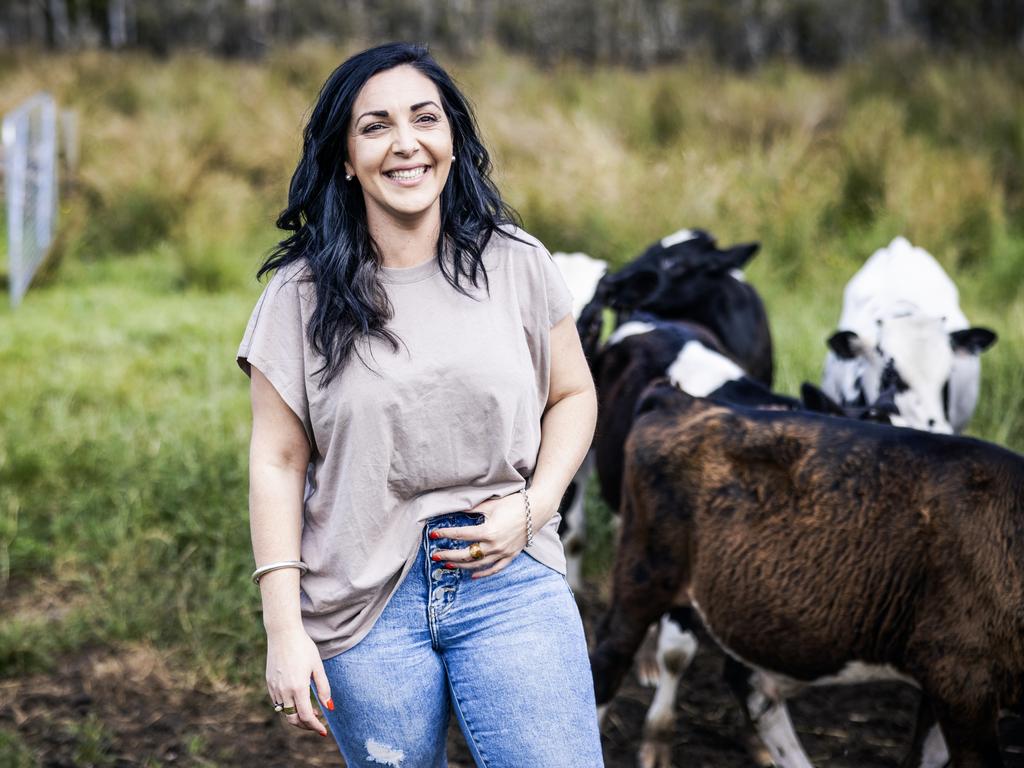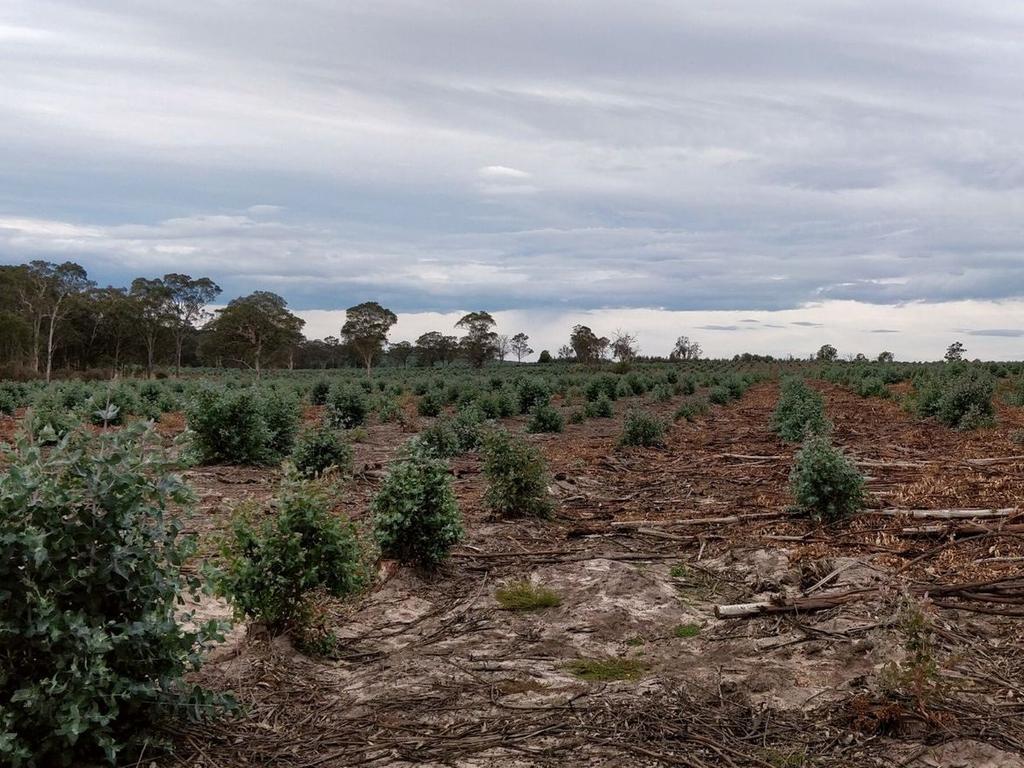‘Monstrous’: Farmer says he was blindsided by proposed 150-megawatt solar farm next door
A major solar farm project has sparked a war of words in a tiny farming community, with neighbours blindsided by ‘monstrous’ proposal.
A major renewable energy project in rural Victoria has sparked a war of words in a tiny farming community, with neighbours claiming they were blindsided to learn of the “monstrous” proposal and the landowners hitting back to defend the lucrative deals.
The proposed 150-megawatt solar farm and battery energy storage system in Bairnsdale, three-and-a-half hours east of Melbourne in the Gippsland region, would be the same size as South Australia’s Tesla “big battery” in the state’s arid mid-north.
It’s one of five major solar energy battery projects being developed by BNRG Leeson, a joint venture between Dublin-based BNRG Renewables and Melbourne’s Leeson Group.
But the 176-hectare project, which will be considered for approval by Victoria’s Department of Transport and Planning (DTP) in coming months, has drawn the ire of locals and the broader farming community, who say the state and federal Labor governments have thrown “common sense out the window in the race to renewables” and stripped communities of their rights.
“We’re fighting both the state and federal government — they’re panicking because [Victoria] has got this commitment for 95 per cent renewable energy by 2035,” said Michael Wickfeldt, 62, whose 86-acre farm neighbours the proposed site at Andersons Lane next to the Moormurng state forest.
“[Premier] Jacinta Allan has seen it within her powers to block [Victorian Civil and Administrative Tribunal] objections, so any objections for a renewable energy facility, whether it is appropriately or inappropriately sited, will be decided by the department.”

Mr Wickfeldt said he only learned of the proposal via social media last August, which would see 166,800 solar panels placed about 60 metres from his house, with the battery 750 metres away.
“The battery itself has a footprint of 10 acres — it’s monstrous,” Mr Wickfeldt said.
He and others have raised concerns about the risk of fires and toxic gas release, potential disruption to nearby Bairnsdale Airport, and the loss of “amenity” and impact on surrounding land values.
Construction on the solar farm is slated to begin in late 2025 if approved. It would ultimately produce enough energy to “power 20,000 homes around Victoria”, according to BNRG Leeson.
Mr Wickfeldt said he believes that there will be toxic “vapour release” which can occur when lithium-ion batteries go into “thermal runaway”.
“We are often downwind of where they’re going to place this battery, it’ll blow these toxic vapours directly at us and we won’t get any warning,” he claimed.
“This place will be manned Monday to Friday for normal business hours, so if it happens after hours or on the weekend no one’s even going to be here to do any mitigation work.”
In such an event, the battery would be sprayed with water to catch the aerosol vapours.
“I’ve got a southern paddock directly beneath where this battery is going to be, so this toxic firewater is going to be flowing directly into my paddocks,” he said.
He added that documents published by BNRG Leeson to date had not addressed any of these concerns. The company sent a delegation to speak to locals after being contacted directly last year.

“They basically took the line of the government that fossil fuels are damaging the environment, that climate change is a real issue and this is our proposal to do something about it,” Mr Wickfeldt said.
The land for the proposed solar farm is owned by two locals, accountant Ken White and farmer Nelson Cox.
Mr Cox, 55, who owns the much larger portion of the land and borders Mr Wickfeldt, said he was “sympathetic” to his neighbour’s concerns and BNRG Leeson was “prepared to put a buffer zone” around the panels with a screen “to keep him happy”.
“I would have thought the actual site, you couldn’t get a more secluded site that has very little impact on other areas,” he said.
“In my opinion, if this can’t get up, I don’t think any can. The impact is very low.”
Mr Cox said the “thing I’m most passionate about is this area needs investment”.
“We’ve lost our timber industry, we’ve had a downturn in a lot of areas, here’s our opportunity to keep a local resource,” he said.
“We cannot keep turning away investment in the East Gippsland region, there’s got to be some sacrifice. There seems to be a culture in this area that we just oppose everything. I’m very sympathetic with the neighbours in the area and I believe this ticks most boxes. I reckon the emotion needs to be taken away from it.”
Mr White, 45, said he acknowledged neighbours’ concerns and “everyone’s entitled to have their opinion on it”, but he believed it was making good use of “very, very low-value agricultural land which doesn’t support any full-time jobs”.
BNRG Leeson estimates the project value at $150 million to $200 million, with a large component to be spent on local contractors and labour.
It will support up to 180 jobs during construction, and 12 full-time jobs when in operation.

“I live there too, I’m totally conscious of the potential impact on them, I’m trying to mitigate that,” Mr White said.
“The land in its previous life was a 1000-acre blue gum plantation. This land was largely unmanaged — it was inundated with hundreds of roos, wombats and other vermin. No one had an issue with the amenity then, but we do now. That’s what I find a little bit ironic. Some of the neighbours were looking at a 12-metre-high wall of blue gums five years ago, now we’re potentially going to be looking at a three-metre-high wall of solar panels and we’ve got a problem.”
Both men disputed claims that neighbours were not aware and said they were disappointed few had spoken to them directly about their concerns.
They said the risk of fire or vapour release was low and that battery technology had improved after similar events.
Based on the pay arrangements for similar renewable projects in the area, Mr White and Mr Cox could stand to earn around $200,000 per year under a 30-year lease.
Mr White said it was “publicly known” that the average rate for similar renewable energy leases was “somewhere around $1500 a hectare” and confirmed he expected the project to receive “around that $200,000-a-year mark”.
Mr Cox said he was “not prepared to disclose the figures”.
“At the end of the day, the return to me, I’m not going to lose any sleep at night, it’s not a big thing,” he added.
Mr White said the project “proceeding or not financially is not going to change my life”.
“It’s not the reason I’m doing it — the reason I’m doing it is Australia has a path to net zero, that means we have to consider renewable energy projects in some areas where a minority don’t want them, but the reality is they have to go there,” he said.
“Would there be a minority of people in that region that might not want it there because it may interrupt their rural view? Absolutely. But the majority of Australia recognises that this is pathway our federal government and others have said we need to go down.”

Emma Germano, president of the Victorian Farmers Federation, said renewable energy facilities “have gone from being something that communities welcomed to completely losing social license on the basis that there is little or no consultation with the community”.
“The state government has taken away the community’s avenues to question projects and the impact on the environment, which includes landholders — particularly on adjoining landholders, who are often forced to be the buffer of a renewable energy zone without being compensated,” she said.
“In this particular instance, we know there are some grave concerns about safety. That’s been raised with the [Country Fire Authority], now we’re going to seek to have a conversation with the [Electrical Trades Union]. We’re now talking about projects that are getting streamlined to the detriment of being able to firmly test they’re safe.”
Planning Minister Sonya Kilkenny last month approved the first renewable energy project under the state government’s new streamlined process introduced earlier this year.
The planning application for the 350-megawatt Joel Joel Battery in the Northern Grampians, which will be the largest in Australia, was fully processed in just nine weeks under the new fast-tracked pathway.
“Victoria’s ageing coal-fired generators are closing and the cost of fossil fuels are rising globally — streamlining planning approvals for projects like this one will ensure we can keep the lights on and power prices down,” Ms Kilkenny said in a statement at the time.
Ms Germano said the Victorian government had “eroded completely” any rights to object and its behaviour had caused the VFF to revise its position on renewable energy.
“Five years ago we were saying it’s great farmers have the opportunity to diversify their income,” she said. “What we’re seeing now is inappropriate developments impacting neighbours and complete disregard for agricultural production.”
She noted that Victorian farmers and landholders made up 1.5 per cent of Australia’s landmass but produced 30 per cent of the food.
“Then they want to go and put renewable energy facilities right on top of prime farming land,” she said.
“It’s horrific. There’s so much space but instead we’re putting these facilities on the best land. We’re seeing one outcome being placed over another. In the mad race to renewables now I think most people are feeling like it’s completely ideological and common sense has gone out the window.”

A spokesman for the East Gippsland Shire Council referred to a statement issued last month, which noted the decision was out of council’s hands under Victorian law.
Mayor Tom Crook said the council had already provided “initial advice” to the department outlining some of the community’s concerns and would make a formal submission once the application was lodged by BNRG Leeson this month.
“We have been approached by some surrounding property owners who have concerns about the project,” Cr Crook said.
“They will also have an opportunity to make formal submissions to the Department of Transport and Planning outlining those concerns. Once we have seen the completed application and technical reports, council will carefully consider the proposal and make a submission to the Victorian government. Council is not the decision-maker, but we will ensure that community concerns are conveyed to the Minister.”
The DTP said it had not yet received a planning permit application for the Bairnsdale solar farm.
“Any proposal would be considered on its merits,” a spokeswoman said on Friday.
“If an application is lodged, the department will notify surrounding landowners, as well as the local council and other relevant bodies who will be able to provide submissions.”
BNRG Leeson has been contacted for comment.
It comes after Aussie TV legend Catriona Rowntree, host of Nine’s Getaway, accused the Victorian Labor government of secretively fast-tracking major renewable energy projects without properly consulting with affected communities.
Rowntree, 53, said last month she was shocked to learn of a massive renewable energy battery project next to her farm in Little River, southwest of Melbourne, arguing the 770-hectare location at the base of the You Yangs Regional Park, just outside Geelong, was “prime agricultural land” and prone to bushfires.
She told ABC radio the state government was trying to “sneak through” the proposal “and the council did not know”.
“I’m feeling like the canary in the coal mine,” she said. “If you don’t know something’s happening, how can you object? That’s what happened to us.”






